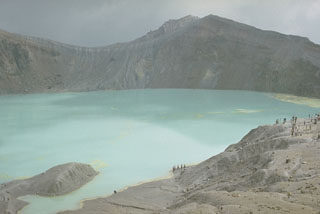Report on Kusatsu-Shiranesan (Japan) — December 1982
Scientific Event Alert Network Bulletin, vol. 7, no. 12 (December 1982)
Managing Editor: Lindsay McClelland.
Kusatsu-Shiranesan (Japan) Volcanic tremor, phreatic explosion
Please cite this report as:
Global Volcanism Program, 1982. Report on Kusatsu-Shiranesan (Japan) (McClelland, L., ed.). Scientific Event Alert Network Bulletin, 7:12. Smithsonian Institution. https://doi.org/10.5479/si.GVP.SEAN198212-283120
Kusatsu-Shiranesan
Japan
36.618°N, 138.528°E; summit elev. 2165 m
All times are local (unless otherwise noted)
At 0538 on 29 December, after 64 days of quiescence, a phreatic explosion from the pit formed in the 26 October explosion ejected a gray plume that rose about 300 m above the rim of Yugama Crater. The plume was 700 m above the rim by 1300, then suddenly declined about 1500. The seismograph at the Maebashi District Meteorological Observatory, 1.1 km NE of Yugama, began to record volcanic tremor 46 minutes before the explosion. Maximum amplitude was 2.1 µm. Tremor ended at 1538, but resumed at 1900 and continued until 1500 the next day. Ash traveled as far as 4 km, mainly NE. Scattered blocks and ejecta carried by spraying water were observed around the pit, including clay material on 30 December. No damage was reported. As of 5 January, no further explosions had been reported, but tremor had been continuous since 2 January.
Geological Summary. The Kusatsu-Shiranesan complex, located immediately north of Asama volcano, consists of a series of overlapping pyroclastic cones and three crater lakes. The andesitic-to-dacitic volcano was formed in three eruptive stages beginning in the early to mid-Pleistocene. The Pleistocene Oshi pyroclastic flow produced extensive welded tuffs and non-welded pumice that covers much of the E, S, and SW flanks. The latest eruptive stage began about 14,000 years ago. Historical eruptions have consisted of phreatic explosions from the acidic crater lakes or their margins. Fumaroles and hot springs that dot the flanks have strongly acidified many rivers draining from the volcano. The crater was the site of active sulfur mining for many years during the 19th and 20th centuries.
Information Contacts: JMA, Tokyo.

